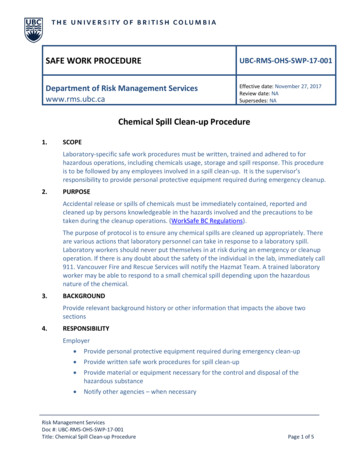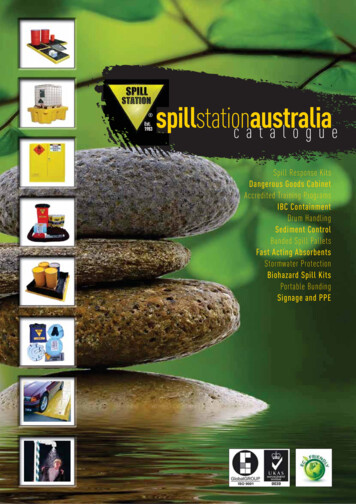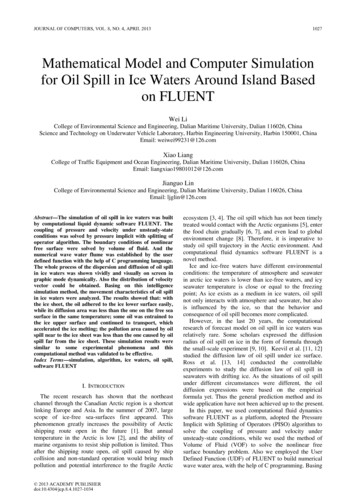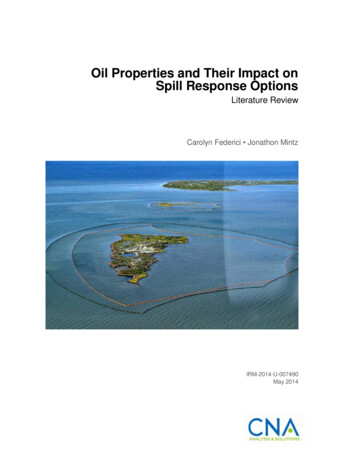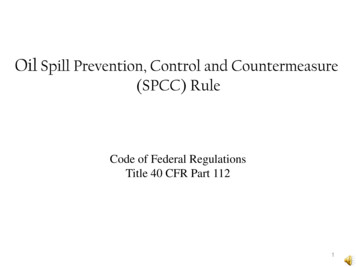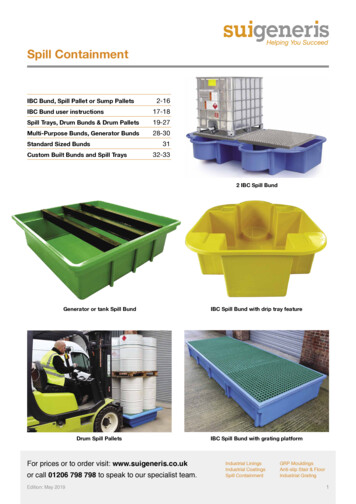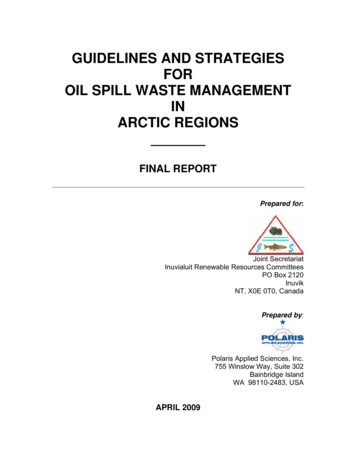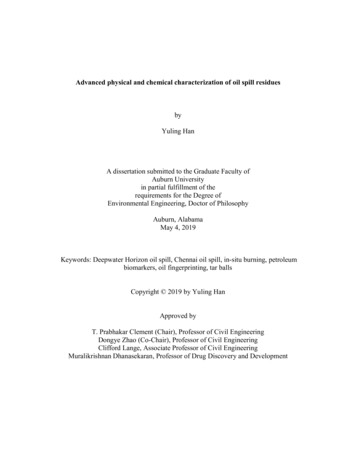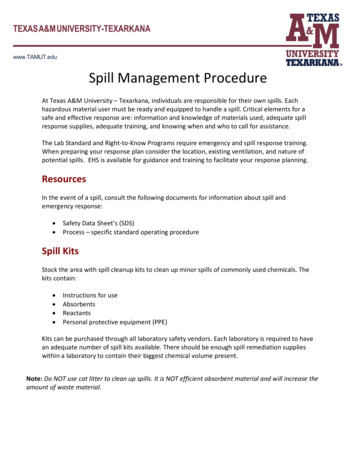
Transcription
www.TAMUT.eduSpill Management ProcedureAt Texas A&M University – Texarkana, individuals are responsible for their own spills. Eachhazardous material user must be ready and equipped to handle a spill. Critical elements for asafe and effective response are: information and knowledge of materials used, adequate spillresponse supplies, adequate training, and knowing when and who to call for assistance.The Lab Standard and Right-to-Know Programs require emergency and spill response training.When preparing your response plan consider the location, existing ventilation, and nature ofpotential spills. EHS is available for guidance and training to facilitate your response planning.ResourcesIn the event of a spill, consult the following documents for information about spill andemergency response: Safety Data Sheet’s (SDS)Process – specific standard operating procedureSpill KitsStock the area with spill cleanup kits to clean up minor spills of commonly used chemicals. Thekits contain: Instructions for useAbsorbentsReactantsPersonal protective equipment (PPE)Kits can be purchased through all laboratory safety vendors. Each laboratory is required to havean adequate number of spill kits available. There should be enough spill remediation supplieswithin a laboratory to contain their biggest chemical volume present.Note: Do NOT use cat litter to clean up spills. It is NOT efficient absorbent material and will increase theamount of waste material.
Procedure: Responding to a Minor Chemical Spill Notify all individuals in the general vicinity that a spill has occurredIsolate the area and keep other personnel out of the contaminated areaIf spilled material is flammable, turn off ignition and heat sourcesAvoid breathing vapors from spill, and if possible, open outside windowsDo you have the training equipped to clean up the spill?o If NO, call 911 and go to step 11o If YES, then go to next stepPut on personal protective equipment (PPE), including:o Safety goggleso Gloveso Long-sleeve lab coatsConfine spill to as small an area as possibleo Do NOT wash spill down the drainUse appropriate spills kits or absorbents to neutralize corrosives, absorb the spill, orboth.o For powdered chemicals, use one of the following methods to clean up the spill: Sweep carefully to avoid generation of dust Use moist absorbent pads Wet the powder with a suitable solvent and wipe with a dry clothCollect contaminated materials and residues and place them in a containerClean the spill area with waterNotify Pi/SupervisorProcedure: Responding to a Minor Chemical SpillA major chemical spill is one that CANNOT be cleaned up safely without the assistance of EHSand emergency personnel.Note: For major spills or significant areas of contamination, call 911.ResourcesIn the event of a spill, consult the following documents for information about spill andemergency response: Safety Data Sheet’s (SDS)Process – specific standard operating procedure
Procedure: Responding to a Major Chemical Spill Attend to injured of contaminated personnel and remove them from exposureNotify all individuals in the general vicinity that a spill has occurredEvacuate the areaIf spilled material is flammable, turn off ignition and heat sourcesCall 911Close doors to affected areaPost warnings to keep personnel from entering the areaHave a person with knowledge of the incident and area available to assist emergencypersonnelWere there any illnesses or injuries as a result of the incident?o If YES, contact your PI/supervisor or EHS for proper injury notificationProcedure: Responding to a Spill Near a Drain or on aPermeable SurfaceThe purpose of this procedure is to prevent chemical and other material from entering stormdrains, groundwater, detention and retention ponds, and any and all other bodies of water. Notify all individuals in the general vicinity that a spill has occurredIsolate the area and keep other personnel out of the contaminated areaNotify PI/supervisorDo you have the training and equipment to clean up the spill?o If NO, call 911o If YES, then Large material spills Block drains that could be impacted by the spill using:o Spill absorbent materialso Drain plugso Berms Small material spills Clean up spill usingo A chemical spill pad, pillow, and/or absorbent Other material spills Clean up spill usingo Sawdusto Vermiculiteo Oil-dryCollect spilled material into containers to prevent them from entering a storm ofsanitary drain or from evaporating
Place the materials used to clean up the spill, such as debris and personal protectiveequipment (PPE), in a sealed containerLabel all containersWere there any illnesses or injuries as a result of the incident?o If YES, contact your PI/supervisor or EHS for proper injury notificationHow to Respond to Spills:Types of SpillsChemical Isolate the spill area and alert others in the area.Determine identity of spilled material and consult SDS to determine potential hazard(s).Avoid breathing vapors, get as much fresh air into area as you can safely.Establish ventilation to the outside if safe to do so and action does not spread thecontaminant through the building.
Use absorbents and neutralizing agents that are compatible with chemical spilled.Prevent spilled chemicals from going down drains to avoid affecting the environment.Dispose of cleanup materials as chemical hazardous waste; small volumes ( 100ml) ofdilute acids and bases may be neutralized (pH 6-8) and properly disposed of.Call EHS at 903-334-6794 for any spill management guidanceSimple Spills – Liquid Alert people in areaWear personal protective equipment (PPE)Contain by diking with appropriate absorbentIf flammable, remove ignition sources (burners, motors, anything that could cause aspark); use plastic or nonmetallic cleanup equipmentAbsorb or neutralize with appropriate agent working from outside edges inward;sorbents do not remove toxic or flammable hazards; neutralization can produce heatcausing boiling and splatteringo acid—use sodium bicarbonate or acid spill kito base—use sodium bisulfate, citric acid, or base spill kito formaldehyde--absorb or polymerizeSimple Spills – Solid if not water reactive, dampen to prevent airborne dustcontrol water reactive dust with sweeping compoundcarefully brush solids into a dust pan or containerkeep dust generation down to prevent creating inhalation hazardCompressed gas leak—simple (presents no or only minimal inhalation or fire hazard) remove ignition sources restrict access place in or next to fume hood if possible; tighten fittings locate leak with soapy water (at below freezing temperatures use 50% glycerin solution) if cylinder still leaks, contact supplierCompressed gas leak – majorLarge or uncontrollable leak or fire hazard, involves acutely toxic gas, and/or more thanminimal personal risk alert others to evacuate call 911 turn off ignition sources leave fume hoods running; ventilate the affected area prior to leaving the area (only if itcan be done safely and only to the outside)
evacuate; assemble in a remote location; account for peopleprovide information to emergency respondersMercuryLarge or heated spills can be an inhalation hazard isolate area to prevent tracking wear gloves and shoe covers (if on floor) consolidate and collect droplets using scraper, cardboard, wet paper towel, aspiratorbulb, tape or special sponge. place all waste in sealed container; contact EHS at 903-334-6794 for hazardous wastepickupNote: For major spills of mercury, evacuate immediately and call 911Radiation Spill ResponseSpreading of radiation beyond the spill area can easily occur by the movement of personnelinvolved in the spill or cleanup effort. Prevent spread by confining movement of personnel untilthey have been monitored and found free of contamination. A minor radiation spill is one thatthe laboratory staff is capable of handling safely without the assistance of safety andemergency personnel. All other radiation spills are considered major.Minor Radiation Spills Alert people in immediate area of spill.Call 911, radiation safety officer, and EHS.Wear protective equipment, including safety goggles, disposable gloves, shoe covers,and long-sleeve lab coat.Place absorbent paper towels over liquid spill. Place towels dampened with water overspills of solid materials.Using forceps, place towels in plastic bag. Dispose in radiation waste container.Monitor area, hands, and shoes for contamination with an appropriate survey meter ormethod. Repeat cleanup until contamination is no longer detected.Major Radiation Spills Attend to injured or contaminated persons and remove them from exposure.Alert people in the laboratory to evacuate.Have potentially contaminated personnel stay in one area until they have beenmonitored and shown to be free of contamination.Call 911, radiation safety officer, and EHS.Close doors and prevent entrance into affected area.Have person knowledgeable of incident and laboratory assist emergency personnel.
Biological Spill ResponseBiological spills outside biological safety cabinets will generate aerosols that can be dispersed inthe air throughout the laboratory. Wait 30 minutes prior to initiating spill clean up to allowaerosols to settle or be removed by the ventilation system.BSL 1 Level Spill Wear disposable gloves.Soak paper towels in disinfectant and place over spill area.Place towels in plastic bag for disposal.Clean spill area with fresh towels soaked in disinfectant.BSL 2 Level Spill Alert people in immediate area of spill.Put on protective equipment.Cover spill with paper towels or other absorbent materials.Carefully pour a freshly prepared 1 in 10 dilution of household bleach around the edgesof the spill and then into the spill. Avoid splashing.Allow a 20-minute contact period.Use paper towels to wipe up the spill, working from the edges into the center.Clean spill area with fresh towels soaked in disinfectant.Place towels in a plastic bag and decontaminate in an autoclave.Chemical and Material FiresSmall fires can be extinguished without evacuation. However, an immediate readiness toevacuate is essential in the event the fire cannot be controlled. Fire extinguishers should beused only by trained personnel. Never enter a room that is smoke filled. Never enter a roomcontaining a fire without a backup person. Never enter a room if the top half of the door iswarm to touch. Always dial 911 to ensure the Fire Department is notified of any fire even if it isminor and has been successfully extinguished.Minor Fire Alert people in laboratory and activate alarm.Smother fire or use correct fire extinguisher.Aim extinguisher at base of fire.Always maintain accessible exit.Avoid smoke or fumes.
Minor Fire Alert people in area to evacuate.Activate nearest fire alarm or call Fire Emergency Response number.Close doors to confine fire.Evacuate to safe area or exit building through stairwell; do not use elevator.Have person knowledgeable of incident and laboratory assist emergency personnel.Personal Injury ResponseHazardous Material Splashed in Eye Immediately rinse eyeball and inner surface of eyelid with water continuously for 15minutes. Forcibly hold eye open to ensure effective wash behind eyelids. Obtain medical attention. Report incident to PI/supervisor and EHS.Radiological Spill on Body Remove contaminated clothing. Rinse exposed area thoroughly with water. Obtain medical attention, if necessary. Report incident to PI/supervisor, EHS and Radiation Safety Officer.Chemical Spill on Body Flood exposed area with running water from faucet or safety shower for approximately15 minutes. Remove contaminated clothing at once. Make sure chemical has not accumulated in shoes. Obtain medical attention, if necessary. Report incident to PI/supervisor and EHS.Emergencies Involving Fire on Clothing Roll person around on floor to smother flame, or drench with water if safety shower isimmediately available. Obtain medical attention, if necessary. Report incident to PI/supervisor and EHS.
Biological Spill on Body Remove contaminated clothing. Wash exposed area with soap and water for approximately 15 minutes. Obtain medical attention, if necessary. Report incident to PI/supervisor and EHS.Minor Cuts and Puncture Wounds Wash injury with soap and water for several minutes. Obtain medical attention. Report incident to PI/supervisor and EHS.
REVISION STATUSCONTACT(S)IMPLEMENTATION DATECOMMENTSHeather Vogt, EHS ManagerMay 2022Created procedure
Dispose of cleanup materials as chemical hazardous waste; small volumes ( 100ml) of dilute acids and bases may be neutralized (pH 6-8) and properly disposed of. Call EHS at 903-334-6794 for any spill management guidance Simple Spills - Liquid Alert people in area Wear personal protective equipment (PPE)

